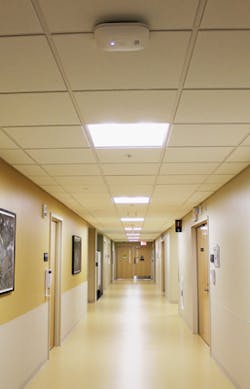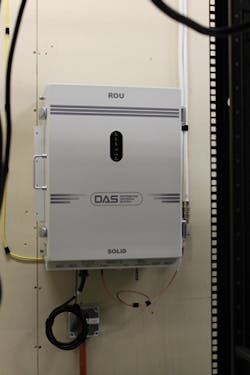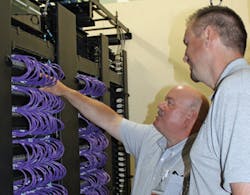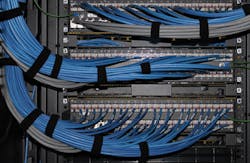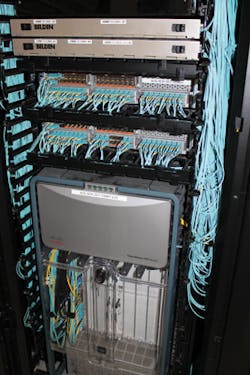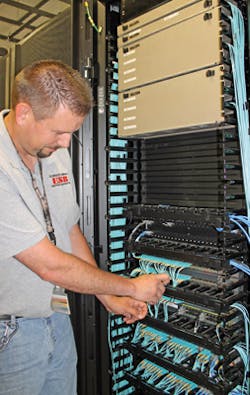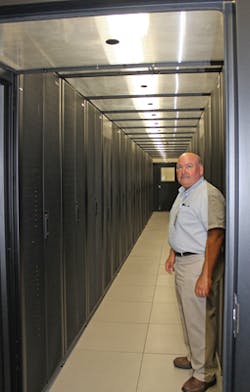From the September, 2014 Issue of Cabling Installation & Maintenance Magazine
The new MaineGeneral Medical Center was constructed using an integrated project delivery approach that included the cabling infrastructure.
By Jim Salvo, FAS & Associates; and Nick Kasap, RCDD, Belden
When a state-of-the-art $322-million, 640,000-square-foot hospital built from the ground up opens seven months ahead of schedule and millions of dollars under budget with every network port live and ready to transmit critical healthcare information, it's obvious that something was done right. That's exactly what happened at the new MaineGeneral Medical Center in Augusta, ME.
In what has been described as the single-largest hospital financing project in the state's history, the new 192-bed MaineGeneral Medical Center consolidates all inpatient services from two existing hospitals in Augusta and Waterville to deliver the latest medical technology in a natural patient- and family-focused environment. Officially named the MaineGeneral Medical Center Alfond Center for Health-after philanthropist Harold Alfond, who wanted the people of central Maine to have access to the best health care-the new Gold LEED-certified facility sits on 172 acres that were formerly used as a dairy farm and most recently as a golf course. It features three super-sized operating rooms, a cardiac catheterization lab, seven specialty operating rooms, six procedure rooms, a streamlined emergency department, medical library, meeting space for up to 300 people, private patient rooms and plenty of family-friendly spaces.
In a collaborative strategic planning process, MaineGeneral used a true integrated project delivery (IPD) approach that included the use of innovative planning, design and construction techniques, and selected partners with the expertise, service and products to ensure value and facilitate a highly successful project. Anticipated to ultimately reduce operating expenses by more than $7 million annually, the hospital's innovative care tactics, advanced medical technology, and efficient facility operations rest largely on the network cabling infrastructure that was also strategically planned, designed and deployed using high-quality, end-to-end copper and fiber cabling systems from Belden.
Investing in the plan
Through an agreement with architects SMRT Inc. of Portland, ME and TRO Jung Brannen (TRO JB) of Boston, MA, and general contractor H.P. Cummings, MaineGeneral set out to construct the new medical center using a collaborative IPD approach, which is fast becoming a new trend in construction management for large, complex projects. Established in 2007 by the American Institute of Architects' California Council, IPD requires all stakeholders to collaborate throughout the entire planning, design and build process rather than handing off responsibility once their part of the work is done.
With a strong focus on communication, the goal of IPD is to eliminate waste early in the design process and allow for sharing of information across a variety of trades to ultimately maximize efficiency and reduce cost. IPD also employs the use of innovative design and construction technologies, such as building information modeling (BIM) to generate digital representations of spaces for effective decision-making and lean construction methods.
Chuck Hays, president and chief executive officer of MaineGeneral, credits the IPD approach with putting the new hospital well under budget and ahead of schedule. "While IPD is still in its infancy, it has really shown a lot of promise from both a schedule and cost perspective. By having all contractors in on the design process, they can immediately tell you a better or cheaper way to do something," he says.
One example of the IPD approach was the early decision to use extensive prefabrication that would enable continued construction of the hospital through Maine's potentially harsh winter weather. This included fabricating and assembling entire walls with medical gas piping and cabling, and constructing modular bathrooms that could be moved into place as soon as patient rooms became accessible.
While IPD obviously saved MaineGeneral time and money in the long run, it did require a lot of investment in upfront time. The IPD team of owner, architects, engineers, contractors, subcontractors and consultants all co-located in a single offsite office from the very beginning of design all the way through construction to the opening of the doors. The time investment was also evident in the design and deployment of the network cabling infrastructure.
"When patients start coming in, you want the network to be ready to go," says Tim Hallee, network engineer for MaineGeneral. "Through IPD, we actually built mock patient rooms and had staff come in and do multiple 'day-in-the-life' analyses and tell us what they liked and didn't like. That allowed us to resolve any issues long before deployment, and know exactly what we needed from a network perspective."
Hallee used the same IPD process for designing the network spaces within the hospital, building a mock telecommunications room (TR) complete with racks, pathways, cabling and connectivity. He also went beyond the use of BIM, creating detailed rack layouts in Visio that showed individual network connectivity using templates from the equipment manufacturers, including Belden.
"We built the first mock telecom room as designed but ended up not liking some of the cable-management and tray layouts," says Hallee. "We spent several weeks getting the space exactly how we liked it, even working with Belden to make some customized product modifications for fiber patch panels. The finalized telecom room became a template that we used to build out 20 identical telecom rooms, and the detailed rack layouts let the contractors know exactly where every network component needed to be located and how it was connected."
According to Hallee, this approach was instrumental in allowing every network port to be live and performing as intended on the medical center's opening day.
Partnering for success
Another key aspect of the IPD approach to construction management is that it requires all stakeholders to pool their risk, eliminating conflict between trades and the tendency to pass the buck.
"All the major contractors who are part of the IPD contract have all of their profit at risk," says Hays. "If a project comes in on budget, they get the budgeted amount; if it's under budget, they split the difference and 50 percent goes into their profit pool. If it's over budget, it comes 100-percent out of their profits."
With all stakeholders sharing in the wins and the losses, each is highly focused on a successful outcome. For this approach to be successful, potential contractors are carefully evaluated very early in the process to ensure each can be a team player.
"Typically, you think about whether the contractors you select are physically able to do the job. Then you assess whether the bids are apples-to-apples. Then you realign all that and look at pricing. Now though, whether best price or not, culture came first. If they didn't have the flexibility to embrace IPD, then it wouldn't work," says Hays.
Each subcontractor was also integrated into the earliest planning process, which helped reduce cost by purchasing material in advance or providing the flexibility to wait on purchasing cutting-edge technologies without worrying if the facility design will support it. The selection of contractors was also based on the hospital's promise to the community to use as much local labor as possible. Through creative bid packaging and joint ventures between smaller companies, 90 percent of those employed for the construction of the new MaineGeneral Medical Center were Maine residents, with 95 percent of the total labor force from the surrounding New England area.
For the network cabling infrastructure, MaineGeneral partnered with Belden for the end-to-end fiber and copper cable and connectivity system with Belden PartnerAlliance member E.S. Boulos Company, a local full-service contractor that offers complete design-build services for both electrical and low-voltage projects. Both of these partners were selected early in the planning and design stages due to their experience, quality, flexibility and willingness to forge a true partnership within the IPD process.
"Not only did we have experience with healthcare projects and an existing relationship with MaineGeneral, H.P. Cummings and Belden, but our willingness to participate in the IPD process helped solidify the project for us," says Lee Whitaker, E.S. Boulos's telecommunications general foreman and supervisor for the MaineGeneral project. "We ultimately believe that the IPD approach worked out very well because it allowed everybody to be on the same page from day one."
Whitaker, who has been working in the industry for 20 years, has also been familiar with Belden products and quality for seveal years. This was yet another advantage, because the hospital had standardized on Belden more than a decade ago.
"We were familiar with both E.S. Boulos and the Belden products, and that was very important to us because there is no hand-holding-they know what we like and how we want it done, and they work together with Graybar to get us the pricing and products we need," says Hallee. "During planning, we talked about shopping around, but it didn't make sense. We really like the quality of the Belden products and we wanted consistency. And E.S. Boulos is by far the best cabling installer in Maine, and they are one of Belden's top installation partners in this region."
According to Hallee, Belden's customer service and flexibility throughout the project verified that the right partners were chosen. "There were some things we didn't like on other fiber systems and Belden came in with better products and pricing. And what Belden did for us with their ability and willingness to customize fiber and copper patch panels was unique," says Hallee.
Following analysis of the mock TR, Whitaker's crews realized that while the rack-mount fiber patch panels offered several ideal features, they also wanted to have rear access to dress the fiber in without removing the panel. After Whitaker provided pictures and worked closely with his Belden representative to communicate what they wanted, Belden redesigned the FiberExpress 3U rack-mount patch panels with an optional removable rear panel to provide easy access to the rear-side connectivity. Belden was also quick to tweak copper patch panels to accommodate the need for higher bandwidth in some areas of the data center.
"We had already made the decision to go with Category 6 performance for copper connectivity in the data center when some of the server guys asked for Category 6A to support 10 Gigabit Ethernet required by some applications," says Hallee. "Belden came through and told us that they could tweak the patch panels to accommodate six Category 6A ports out of the 48 ports. That was an 'a-ha moment' for us."
In addition to customizing products, Belden also worked closely with E.S. Boulos to make sure they had everything they needed to make their job easier. "We talk to Belden a lot and they listen," says Whitaker. "When they introduce new and different products, they provide us with everything we need to present those products to our customers. And when we ask them to make something better, they respond. During the MaineGeneral project, we requested some enhancements to the cable boxes to ease cable pull off and they quickly came through with a redesign."
In addition to customer service and customization, fast delivery was also critical to having the entire end-to-end network live and ready for opening day.
"It always surprises me when patch cords get overlooked, but in a meeting when we asked who ordered the patch cords, we got nothing but silence," says Hallee. "Belden once again came through and was able to get us our patch cords in a timely manner-we didn't have to delay anything even though we hadn't ordered them up front. And I've never had to call Belden directly for anything-we've always dealt directly with their sales representative and he has always delivered what we need."
According to Whitaker, Belden's ability to deliver product and coordinate with Graybar also helped to ensure that materials were readily accessible when needed. "Graybar had a supply trailer on site and they worked with Belden to get material ahead of time and store it there for easy access. And when there was a certain product we needed in a short timeframe, Belden pushed it through the manufacturing process to make sure we had it in time," says Whitaker. "As a result, we never fell behind schedule, even though the project had a very aggressive timeline."
Designing for resiliency
The network at MaineGeneral's previous facilities was somewhat limited with a traditional PBX-based voice system and cramped telecom spaces that did not allow for additional power and cooling capacity. To deliver superior reliability and support a wide range of advanced hospital systems, including nurse call, patient monitoring, wireless, audio-visual, security, building automation and others, MaineGeneral designed the new network to ensure scalability, redundancy and capacity with 40-Gigabit speeds in the data center backbone and to the 20 TRs.
Within each of the two main distribution areas-one located in the 3,000-square-foot data center and the other at the opposite side of the facility-MaineGeneral deployed Cisco Nexus series 7010 core switches. From the core, 72 strands of Belden FiberExpress Om4 cable connect to Cisco Catalyst 3750 PoE-enabled switches in each TR via the customized Belden FX rack-mount patch panels with integrated rear access.
Within the data center that uses underfloor power and cooling and overhead cabling, a switch fabric architecture was deployed using Cisco Nexus 5000 series switches and Nexus 2000 series fabric extenders to deliver high-density 10-Gigabit Ethernet to servers housed in more than 70 cabinets. Each cabinet also includes KVM distribution for remote management and control of all servers, and Cisco Catalyst 2960 switches were deployed to support additional centralized management throughout the data center for devices such as power distribution units (PDUs).
All fiber connectivity within the data center was accomplished at crossconnects using the Belden FiberExpress Ultra High-Density (UHD) System, a rack-mount fiber-connectivity system that provides superior port access and protection with up to double the density of comparable units. Each FX UHD housed cassettes with LC duplex connectivity at the front for switch connections and MPO-12 connectivity at the rear for connecting to FiberExpress preterminated MPO trunk assemblies used to establish a permanent link between fiber panels.
According to Whitaker, the FX UHD System was extremely easy to install. "I really liked Belden's preterminated fiber system that was used in the data center. It was my first experience with the product, and our crews found it much easier to install and get up and running compared to other solutions," says Whitaker. "The cassettes just popped right into the housing and the preterminated cables were quick and easy to connect."
Hallee also notes that the network is designed and built for maximum resiliency-from the switch fabric and in-row cooling, to centralized management and complete redundancy via two demarcs. "Everything is monitored and racks have power distribution units powered by both our electrical system and uninterruptible power supplies," he says. "The switches in each telecommunications room are also all PoE enabled with power-sharing features so that all power supplies are shared and if any fail, the others pick up the slack."
For the horizontal cabling, MaineGeneral deployed an end-to-end Belden IBDN Category 6 system that provides a guaranteed bandwidth of 250 MHz with performance that exceeds the ANSI/TIA Category 6 performance requirements. Within each of the TRs, Hallee established a cabling scheme for maximum management and aesthetics using Belden KeyConnect patch panels and Cat 6+ modular jacks and cords.
"For the copper crossconnects within each rack, we deployed 1U blank panels above and below 48-port patch panels and then used one-foot patch cords as our standard throughout," explains Hallee. "Not only is it easier to manage and have just one patch cord length on hand, but it also looks better."
From the TRs, more than a million feet of the Belden Category 6 cable connect to approximately 10,000 drops to support a variety of converged systems and devices-everything from the hospital's wireless network, badge access and security surveillance, to patient monitoring, telemetry and building management systems. The hospital's Vocera nurse call system runs over the wireless network, as well as wireless sensors for monitoring refrigerators and RFID systems for tracking staff and equipment. The Category 6 cabling even supports video conferencing and a dedicated operating-room video integration system that can record and broadcast operations.
"Our telecommunications rooms are flexible and modular to support multiple services over the Category 6 cabling-all of which run in the same pathways but are segregated into bundles and color-coded for various dedicated systems," says Hallee. "I can remember getting excited when more and more systems started to converge and migrate to Ethernet. It's incredible how many services can now run over Category 6 cabling-this facility brought all of that together for us."
In addition to a guest wireless network and kiosks for visitors, MaineGeneral was finally able to deploy the distributed antenna system (DAS) that it had always wanted, and provide superior cellular service throughout the facility.
"The use of cellphones used to be a fear factor due to frequencies potentially being close to those of medical technology, but that's no longer the case and virtually everyone has a smartphone," says Hallee. "That's why we decided to install DAS. Our hospital is located in a valley, and we had poor reception before the service providers added a cell tower to the area, which we now use to feed our DAS."
A combination of the innovative IPD approach and choosing partners with experience, flexibility and customer service to provide on-time delivery of quality products designed to meet the specific needs of the hospital, allowed MaineGeneral's entire network to successfully go live before any patients arrived.
"We moved 120 patients from the Waterville and old Augusta facilities in just one day. With all the cabling completed and every port live, the job was done when the doors opened. Because we pushed hard to make this investment pay off, all major issues were resolved well ahead of time," says Hallee.
A certain level of pride among the E.S. Boulos crews was also instrumental in the success of the project, and they have already moved on to renovating the network at the previous Waterville facility, which is now an outpatient facility.
"This was the biggest healthcare project I had ever worked on, and it was a very important one because it's right in our back yard," says Whitaker. "Everything tested out perfectly, and we haven't had any issues. We are very confident in what we installed, and we look forward to continuing to work with Belden and MaineGeneral on future projects at the hospital and other facilities."
Following testing and certification of the Belden converged fiber and copper network cabling infrastructure, MaineGeneral Medical Center received a Belden 25-year warranty and lifetime application assurance that provided additional peace of mind.
"I'm fully confident due to the partners and products that we will have no problems, but having the Belden warranty in place is nice for peace of mind," says Hallee. "Since we opened, the network has run flawlessly-and having absolutely no problems has allowed us to be much more productive and focus on other projects and our other facilities."
Jim Salvo is vice president of FAS and Associates (www.fas-rep.com). Nick Kasap, RCDD, is director of northeast sales for Belden (www.belden.com).




